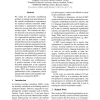103
Voted
ACL
2010
14 years 10 months ago
2010
The translation of sentiment information is a task from which sentiment analysis systems can benefit. We present a novel, graph-based approach using SimRank, a well-established ve...
ACL
2010
14 years 10 months ago
2010
Various text mining algorithms require the process of feature selection. High-level semantically rich features, such as figurative language uses, speech errors etc., are very prom...
76
Voted
ACL
2010
14 years 10 months ago
2010
We show that using confidence-weighted classification in transition-based parsing gives results comparable to using SVMs with faster training and parsing time. We also compare wit...
101
click to vote
ACL
2010
14 years 10 months ago
2010
Tree SRL system is a Semantic Role Labelling supervised system based on a tree-distance algorithm and a simple k-NN implementation. The novelty of the system lies in comparing the...
90
Voted
ACL
2010
14 years 10 months ago
2010
This paper presents ongoing research on computational models for non-cooperative dialogue. We start by analysing different levels of cooperation in conversation. Then, inspired by...
105
click to vote
ACL
2010
14 years 10 months ago
2010
Statistical systems with high accuracy are very useful in real-world applications. If these systems can capture basic linguistic information, then the usefulness of these statisti...
94
Voted
ACL
2010
14 years 10 months ago
2010
We tackle the previously unaddressed problem of unsupervised determination of the optimal morphological segmentation for statistical machine translation (SMT) and propose a segmen...
ACL
2010
14 years 10 months ago
2010
We present a probabilistic model extension to the Tesni`ere Dependency Structure (TDS) framework formulated in (Sangati and Mazza, 2009). This representation incorporates aspects ...
76
Voted
ACL
2010
14 years 10 months ago
2010
In this paper, we propose a novel method for automatic segmentation of a Sanskrit string into different words. The input for our segmentizer is a Sanskrit string either encoded as...
ACL
2010
14 years 10 months ago
2010
This work models Word Sense Disambiguation (WSD) problem as a Distributed Constraint Optimization Problem (DCOP). To model WSD as a DCOP, we view information from various knowledg...

